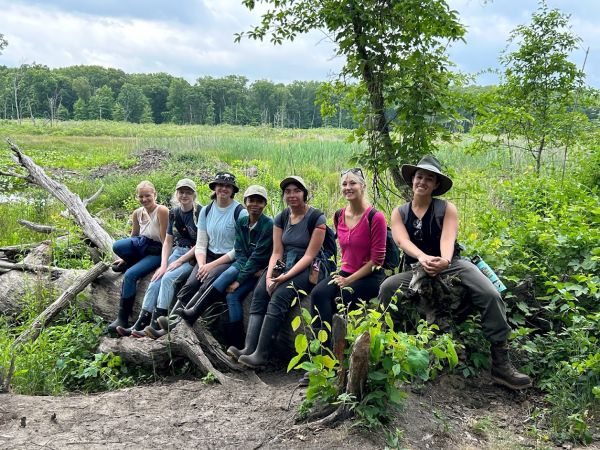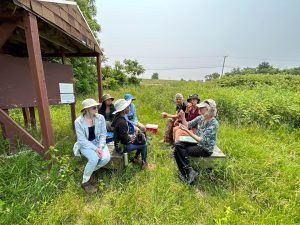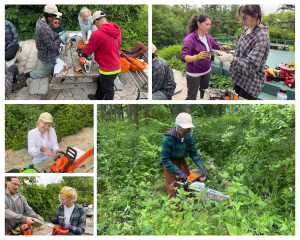
A Trip to the Dunes, Learning to Chainsaw and More – CLIP Week 2!
By Leah Williams
Welcome to the second week of CLIP! This week all the interns picked up a ton of new skills, as we visited everywhere from Irish Oaks and Crowley Oaks, to Glacial Park and even Indiana Dunes. More on that later, but I promise not to keep you in suspense for too long!
On Monday we headed out to Irish Oaks to learn to identify garden valerian and then spray it. It’s been a growing problem there, as the valerian was quietly creeping through the sedge meadow, but not anymore. We spent about five hours spraying it with a 3% mix of triclopyr, and now everyone agrees that herbicide spraying in a sedge meadow where we couldn’t see our feet (or the six inch high hummocks) won’t top the list of favorite field work. But there were the upsides too. We found more blue flag irises than I’ve ever seen before (Emma loved it!) and covered about a quarter mile. Everyone came back hot and tired, but it was a job well done.
The next day we all showed up at Hennen at 6:20 am so we could head to Indiana Dunes early. We met Robert the Park Ranger and trekked the two miles to Lake Michigan. Robert spent the time teaching us different plants like wild lupins, royal ferns, and black oak. Eventually we emerged from the forest out onto the beach. It was a windy day and the breakers were high and loud, so we could hear them from a distance away. When we looked north we could actually see the distant Chicago skyline. I took a picture of it so I could convince my family later that it was actually true! Meanwhile, Emma headed down by the waterline and neatly lettered CLIP 2023 in the sand to say we’d been there.
Farther away from the water the sand was bordered by low dunes with a combination of hoary puccoons with bright yellow flowers, blazingstar, and grasses anchoring them through the constant wind. Then further up the dunes grew higher, with windswept trees that had somehow managed to take root and cause the dunes to become stationary, eventually giving way to woodland sprawled over rolling dunes now buried under topsoil.
Heading back, we paused to see Cowles Bog. I saw water lilies floating on the surface, along with cattails, sedges and an abundance of other plants that Kim will be asked about some time. The bog was named after the ecologist, Henry Cowles, who originally wrote a paper discussing dune ecology in 1899. We all read it for good measure.

In the afternoon, we learned a whole lot of new skills with Mary (Kim’s former supervisor), who taught us by mock conducting our data collection. She set up a 30-foot line between trees in the oak savannah we were working in. Then we put a stake down at three feet and recorded on data sheets the species of plants that touched it, moving three feet along the line every time we moved the stake. It had started to rain steadily about 12:30, and we were grateful to be under the trees. Our data sheets did take a bit of rain, though.
Next Mary laid down a square of PVC pipe with sides three feet long, and we counted all the plant species inside, once again recording them as she taught us their names and codes. I think we all left with a new appreciation of how thoroughly and carefully data collection has to be done! We had to leave at 3:30, but all of us will remember Indiana Dunes well.
The next day we collected Carex rosea seed for the whole morning, then headed out to Glacial Park with Sarah Michehl to learn all about environmental education. We hiked all over the park discussing ecology and teaching, and stopping at various places to identify a female wood duck, or learn about the bog. Sarah described how the water’s acidity increased towards the middle of the bog, and how the leatherleaf that inhabited the area floated on top of water. I’d heard stories before of what happened if one made a misstep, and then crashed through the mat of vegetation into the water below. Nobody working in a bog ever goes out alone for that reason.
We spent the rest of the afternoon learning about geology, and the practical points of teaching outside, such as making sure that a group never has to look into the sun, not wearing sunglasses so you can make eye contact, etc. Later in the internship we’ll be teaching a group of kids, and Sarah’s techniques will definitely come into play.

On Thursday we spent the day at Gateway Park in Harvard, first spraying teasel in the morning, then learning everything there is to know about conservation easements with Lisa over lunch. Discussion ranged from the legal definition of perpetuity, to amendments, to the kind of legal protection the easements have. Lisa also explained the concept of an easement well to us: Land rights are like a bundle of sticks. An easement is created when the landowner voluntarily gives away the particular right to develop the land (giving away some of those sticks), though it is still theirs in all other respects.

Later we got a taste of using the parsnip predators for the first time. It’s immensely satisfying to snap the taproot with the shovel blade and then be able to pull a plant taller than I am out of the ground one handed and fling it away. We didn’t spend a lot of time pulling the parsnips, but might return to finish them off.
And then on Friday we learned how to assemble and disassemble, clean, fuel, and then use chainsaws for the first time with Megan and David. The morning was mostly spent on the back patio until we headed into the woods to practice cutting cookie slices out of a dead limb Megan cut down. After lunch each of us selected a small dead pine and then cut it down the way we’d been taught earlier while Megan instructed and watched like a hawk when she wasn’t. Each of us successfully felled a tree that afternoon.

After that we trooped inside for the first time to do a resume workshop with Dean Eitel, who taught us everything necessary. Then we passed around our resumes and commented in the margins before it was time to head home.
In total, it was an intense week! I loved it though, and we’ll undoubtedly be learning even more and using our new skills as the summer goes on. The CLIP team learned a huge amount this week and we are excited for more!